Fred Appleyard’s Hampshire Years: a life in light and landscape
Step into the world of Fred Appleyard, painter of light and landscape. Book his historic Hampshire home and garden for your photo shoot or creative project.
Fred Appleyard’s Hampshire Years: a life in light and landscape
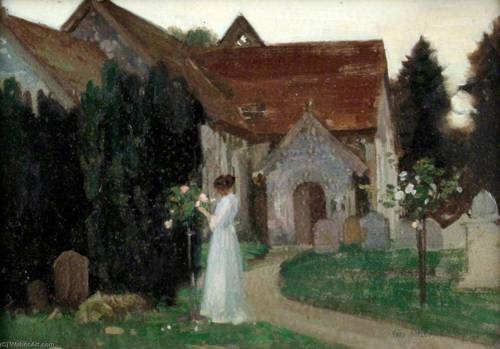
He painted soft, figurative landscapes and became known for the way he captured light. His work is closely tied to the Itchen Valley, where he lived and worked for more than forty years, living and working within the landscape. His home, (that we have named 'Denstow'), appears in several of his works, its gardens and surroundings quietly folded into the scenes he created.
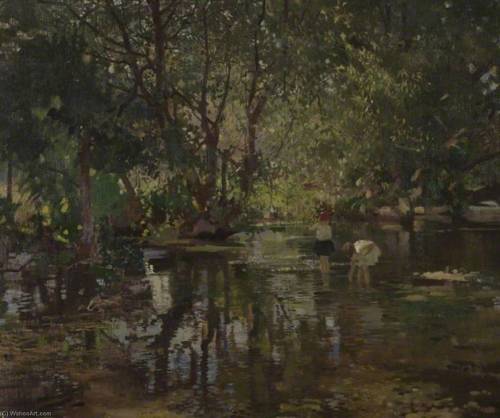
There, he painted what he saw around him: fields, rivers, flowering borders, and quiet moments of everyday life. Many features of Denstow’s grounds appear again and again in his work — low flint walls, espaliered fruit trees, tall hedges casting dappled shade, and light spilling softly across lawns and garden paths.
Now, thanks to a major retrospective exhibition by the Hampshire Cultural Trust, Appleyard’s world has come gently back into view. And what a world it is.
The Making of a Painter
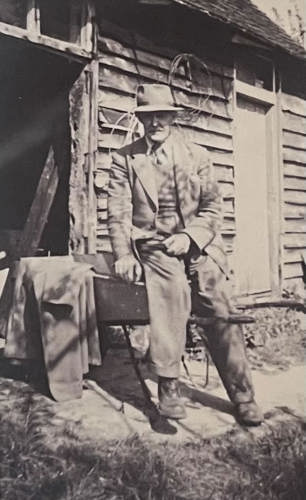
Fred Appleyard was born in the industrial town of Middlesbrough in 1874, the son of an iron merchant. But while the clang of industry echoed outside, young Fred’s attention was drawn to the beauty of everyday life. He was a talented artist from a young age, perhaps inspired by the works of his uncle, the sculptor John Wormald Appleyard.
He began his studies at the Scarborough School of Art under the guidance of landscape painter Albert Strange. It was here he formed a lasting friendship with fellow artist Harry Watson. He moved to London, training first at the National Art Training School in South Kensington and then at the Royal Academy Schools, one of the most prestigious art institutions of the day.
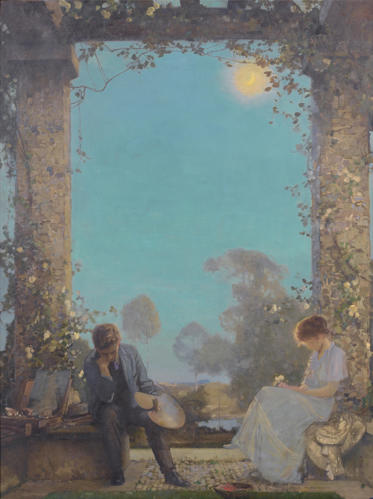
He excelled, earning some of the Academy’s highest honours: the Turner Gold Medal, the Creswick Prize for landscape, and the Landseer Scholarship. His early work was varied, encompassing landscapes, portraits, and allegorical pieces.
Between beauty and industry
As Europe plunged into the First World War, Fred Appleyard’s life and work began to shift. Too old for active military service, he contributed to the war effort at Woolwich Arsenal, a munitions factory on the Thames. It was a world of noise and necessity, far removed from the light-dappled landscapes and tranquil riverbanks that would later define his work. When the war ended, Appleyard left London behind in search of a quieter, rural idyll.
Life in Itchen Stoke
In 1918, Appleyard settled in the Hampshire village of Itchen Stoke, near Alresford. He lived and worked at 'Denstow', a red brick and flint Georgian house nestled within the soft folds of the Itchen Valley. Appleyard remained at 'the house for the rest of his life, drawing inspiration from the surrounding countryside.
His style evolved during this time, subtly shifting to reflect elements of Impressionism. The loose, light-filled brushwork and softened tones of his later landscapes mirrored the slow rhythm of rural life.
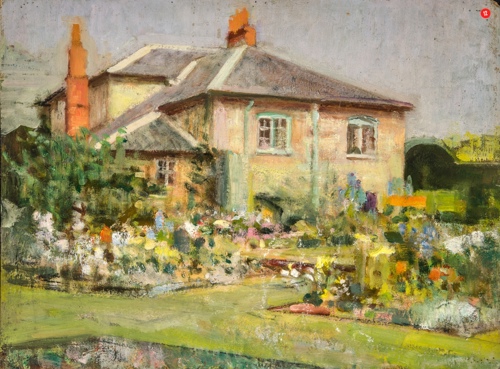
A house in the landscape
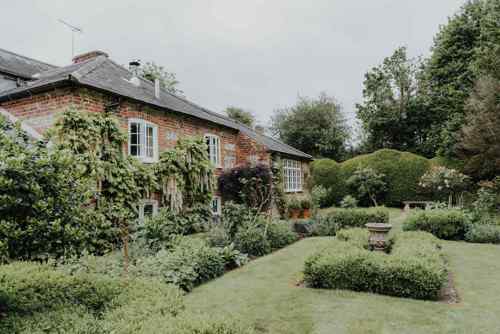
Denstow became a central subject in Appleyard’s art. In one painting, a woman stands by the sundial in the kitchen garden, winter sunlight stretching across the soil.
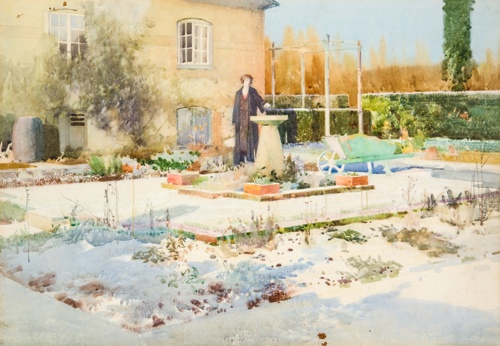
Another painting captures the view from Denstow’s garden, looking out across the soft, rolling hills of the Itchen Valley. Loose brushwork and muted tones give the scene a quiet, contemplative quality. You can just make out espaliered hedgerows and a single red bloom, anchoring the foreground in familiar domestic detail.
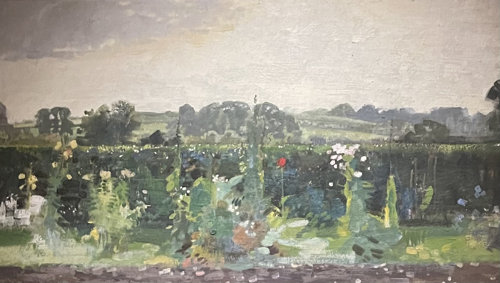
In one especially evocative scene, children rake and paddle at the water’s edge while Denstow rises quietly behind them. The apple trees are in blossom, the garden beds are in full summer colour, and one can almost feel the warmth of a summer’s afternoon emanating from the painting.
These scenes remain recognizable today, with the house still framed by cottage plantings and long views across the Itchen Valley—the same views Appleyard would have seen from his easel.
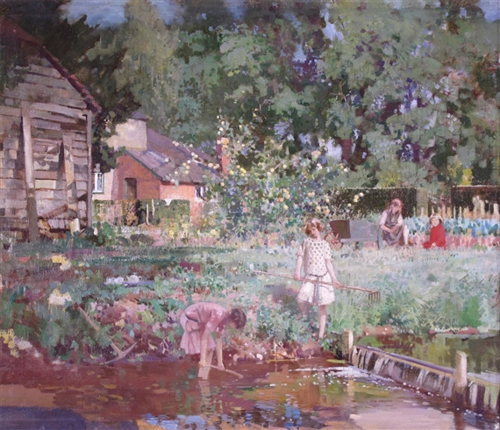
The Golden World of Appleyard
Inspired by the soft light and gentle pace of the Hampshire countryside, Appleyard painted landscapes filled with stillness and quiet beauty. The meadows, streams, and winding paths around his home became recurring subjects, often depicted in early morning or evening light.
 |
 |
Itchen Valley Landscape with Figure & Moonrise over the River Itchen, Fred Appleyard © Estate of the Artist. Photo credit: © Hampshire Cultural Trust
His later work is known for its subtle use of colour and a distinctive technique for capturing sunlight and shadow, particularly through trees. In paintings like Itchen Valley Landscape with Figure (c. 1930) and Moonrise over the River Itchen (c. 1935), light plays a central role. Many compositions feature solitary figures, often women or children, placed gently within the landscape.
Moving away from the classical and allegorical themes of his early work, Appleyard focused on scenes from the natural world around him. These were not grand or imagined landscapes but places he knew intimately.
He painted prolifically, though exhibited less frequently, supporting himself in part by letting his home to visiting fishing parties from the London Stock Exchange. He is also known to have sold his Turner Gold Medal to pay for the installation of electricity at at the house. He died in the village in 1963 and is buried in the peaceful churchyard of St Mary’s.
The Exhibition: Rising Splendour

In 2024, to mark the 150th anniversary of Fred Appleyard’s birth, Hampshire Cultural Trust staged the first major retrospective of his work in nearly a century. Rising Splendour: Fred Appleyard – From the Royal Academy to the Itchen Valley was held at The Arc in Winchester, bringing together more than 100 paintings, drawings and sketchbooks from public and private collections.
The exhibition explored the full arc of Appleyard’s career, from his early success at the Royal Academy to the Hampshire years. It told the story of a little-known painter whose life and work were shaped by rivers, gardens, and soft English light. Alongside well-known finished works were rarely seen field studies, preparatory sketches and personal items.
Step into Appleyard’s world: book Denstow for your next creative project
 |
 |
Denstow, the Georgian house where artist Fred Appleyard lived and worked for over 40 years, is now available to hire through Fablefaine. Tucked away in the Hampshire countryside, it offers a quiet, characterful space for brand shoots, retreats or creative projects. Inside, the house has cosy period features with a lived-in feel. Outside, you’ll find wild gardens, meadows, and a hand-painted gypsy caravan.
Send an enquiry if you are interested in booking Denstow.
Submit to Storia
Submit your story using the form below. We will review your submission and notify you within two weeks if your submission has been accepted. We may ask for some additional information.
If your story is accepted, we will contact you with a publication date.
Submit your story